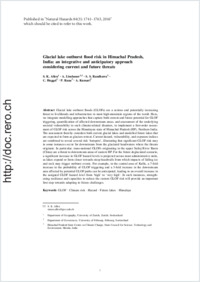Glacial lake outburst flood risk in Himachal Pradesh, India: an integrative and anticipatory approach considering current and future threats
- Allen, Simon K. Department of GeographyUniversity of Zurich, Switzerland
- Linsbauer, Andreas Department of GeographyUniversity of Zurich, Switzerland - Department of GeosciencesUniversity of Fribourg, Switzerland
- Randhawa, S. S. Himachal Pradesh State Centre on Climate ChangeState Council for Science, Technology and Environment, Shimla, India
- Huggel, Christian Department of GeographyUniversity of Zurich, Switzerland
- Rana, P. Himachal Pradesh State Centre on Climate ChangeState Council for Science, Technology and Environment, Shimla, India
- Kumari, A. Himachal Pradesh State Centre on Climate ChangeState Council for Science, Technology and Environment, Shimla, India
-
01.12.2016
Published in:
- Natural Hazards. - 2016, vol. 84, no. 3, p. 1741–1763
English
Glacial lake outburst floods (GLOFs) are a serious and potentially increasing threat to livelihoods and infrastructure in most high-mountain regions of the world. Here, we integrate modelling approaches that capture both current and future potential for GLOF triggering, quantification of affected downstream areas, and assessment of the underlying societal vulnerability to such climate-related disasters, to implement a first- order assessment of GLOF risk across the Himalayan state of Himachal Pradesh (HP), Northern India. The assessment thereby considers both current glacial lakes and modelled future lakes that are expected to form as glaciers retreat. Current hazard, vulnerability, and exposure indices are combined to reveal several risk ‘hotspots’, illustrating that significant GLOF risk may in some instances occur far downstream from the glaciated headwaters where the threats originate. In particular, trans-national GLOFs originating in the upper Satluj River Basin (China) are a threat to downstream areas of eastern HP. For the future deglaciated scenario, a significant increase in GLOF hazard levels is projected across most administrative units, as lakes expand or form closer towards steep headwalls from which impacts of falling ice and rock may trigger outburst events. For example, in the central area of Kullu, a 7-fold increase in the probability of GLOF triggering and a 3-fold increase in the downstream area affected by potential GLOF paths can be anticipated, leading to an overall increase in the assigned GLOF hazard level from ‘high’ to ‘very high’. In such instances, strengthening resilience and capacities to reduce the current GLOF risk will provide an important first step towards adapting to future challenges.
- Faculty
- Faculté des sciences et de médecine
- Department
- Département de Géosciences
- Language
-
- English
- Classification
- Hydrology
- License
-
License undefined
- Identifiers
-
- RERO DOC 278578
- DOI 10.1007/s11069-016-2511-x
- Persistent URL
- https://folia.unifr.ch/unifr/documents/305443
Statistics
Document views: 136
File downloads:
- pdf: 673
